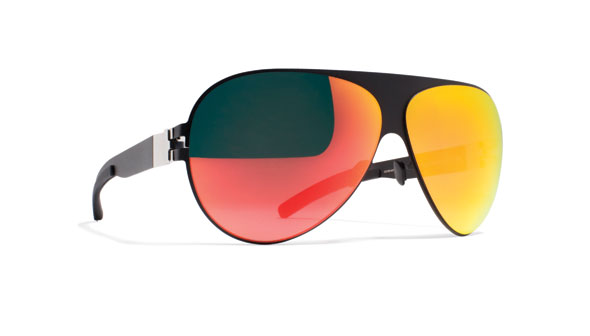
What do Lenny Kravitz and Beth Ditto know that most of us don’t? Well, aside from how to put together massively successful, award-winning albums, they’re both loyal customers of the eyewear brand Mykita. Never heard of them? Don’t worry, there’s a good chance you’ve seen their work.
In fact, if you were simply living in the year 2010, you probably saw their most recognized frames. During that time the Franz mirror aviator would have been visible on thousands of buses, subways, taxis, billboards, television guides, and empty building spaces across the United States and abroad. The face-obscuring shades were worn by Sarah Jessica Parker in nearly every bit of press for the second Sex and the City film. Who needs an ad in a glossy magazine when you’ve got the power of fictitious fashionista Carrie Bradshaw sporting your work?
It’s clever publicity like this that has allowed the brand to avoid the over-saturation of its image from full-forced campaigns and keeps Mykita relevant to both its devoted customers and a growing pack of designers, which collaborate with the eyewear makers.
Started in 2003, the Berlin company was founded by Moritz Krueger, Harald Gottschling, and Philipp and Daniel Haffmans. In 2004, the company released their first optic-wear collection—aptly, and perhaps proudly, dubbed “No. 1.” The collection was well received as much for its clean, no-fuss looks, as it was for featuring their patented snap-hinge design. Mykita explains this technology as being comprised of “simple plug connections,” which cancels out the need for those easily lost, impossibly minuscule screws.
“Each part of the frame is cut out of a 0.5 mm, stainless-steel sheet and then folded into form by hand,” reads the collection’s description. The benefit to all of this—and unique selling point of these frames—is that they are entirely adjustable to the individual wearer’s face.
Form and function were continually considered in their frames in succeeding collections, culminating in their 2007 development of MYLON, a polyamide material—again, patented by the brand—and used alongside a process called “Selective Laser Sintering” (SLS). This manner of production, usually used to create prototypes of objects, allows the crafters of frames to produce an entirely three-dimensional object with relatively zero waste.
Technology aside, it’s the recent collaborations of the eyewear brand, which have begun to spark the interests of fashion editors and tastemakers around the globe. Utilizing the MYLON technology, designer Rad Hourani featured hard, utilitarian sunglasses by the crafters in his Spring/Summer 2011 unisex collection. Another designer, Damir Doma, displayed round lenses on his female models for his 2013 show. From these and other collaborative works, taste-making fashion stylists have begun to pick these lenses for their editorials and shoots. But no one seems to feature the works of this innovative and avant-garde label so much as eccentric performer and pop star Lady Gaga. From big to small, theatrical to subdued, face-hiding to revealing, the artist can be spotted in varying styles and makes from the brand in nearly every paparazzi-snapped photo.
In the face of this increase in success and recognition, Mykita keeps to a primary “holistic business philosophy,” which is to keep all stages of their eyewear production in-house, “under a single roof.”
To learn more, visit www.mykita.com
Text by William Biga

